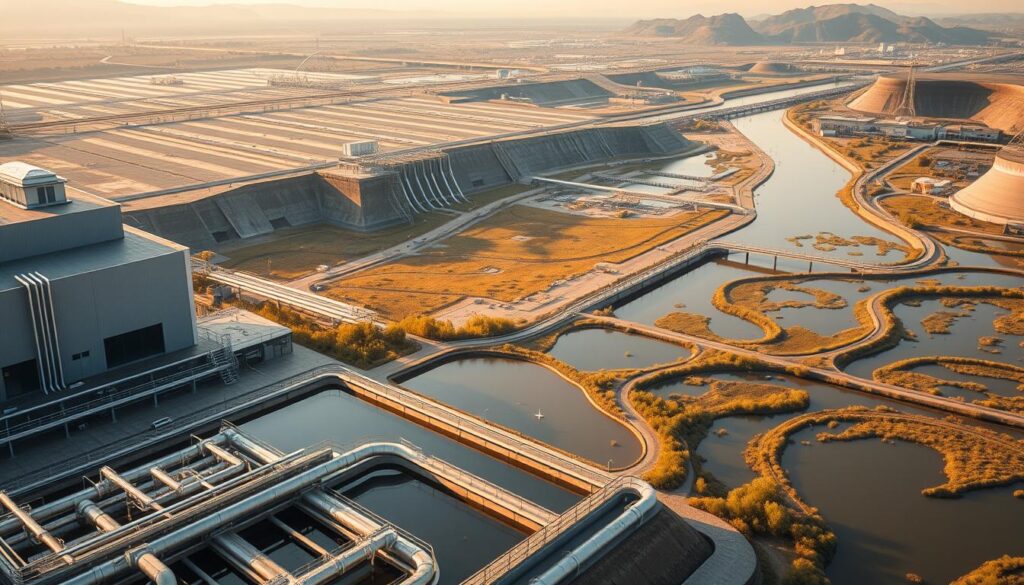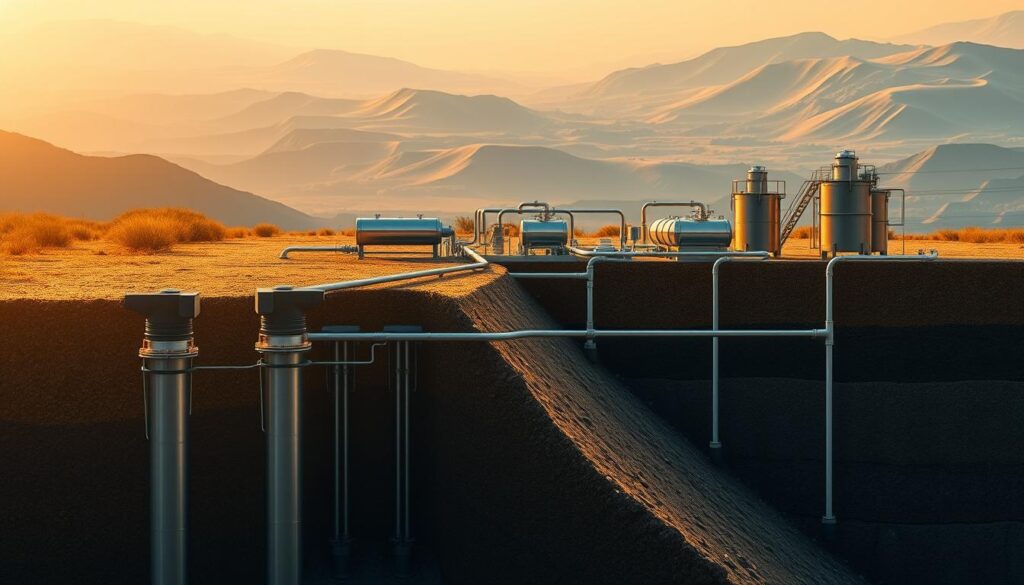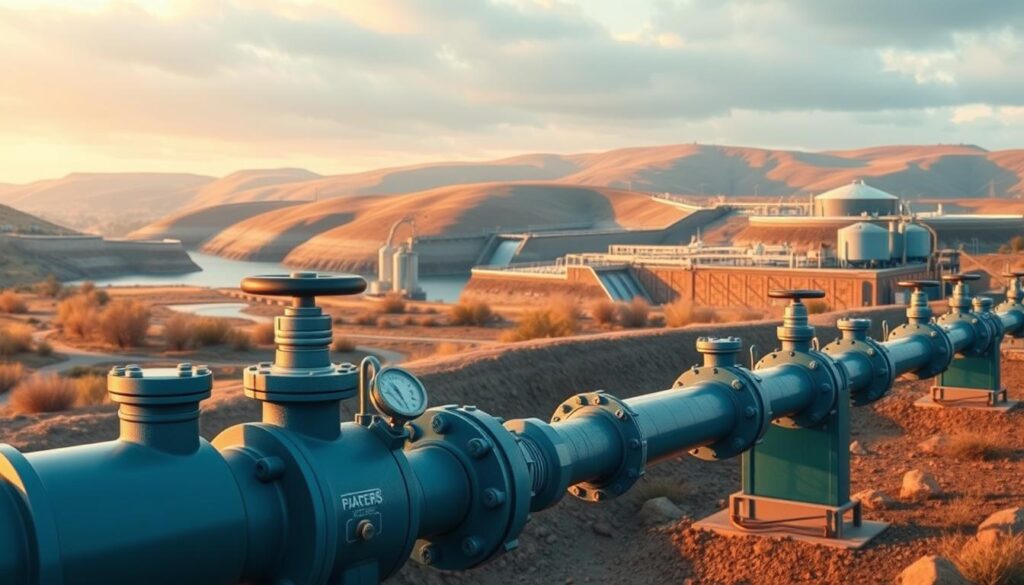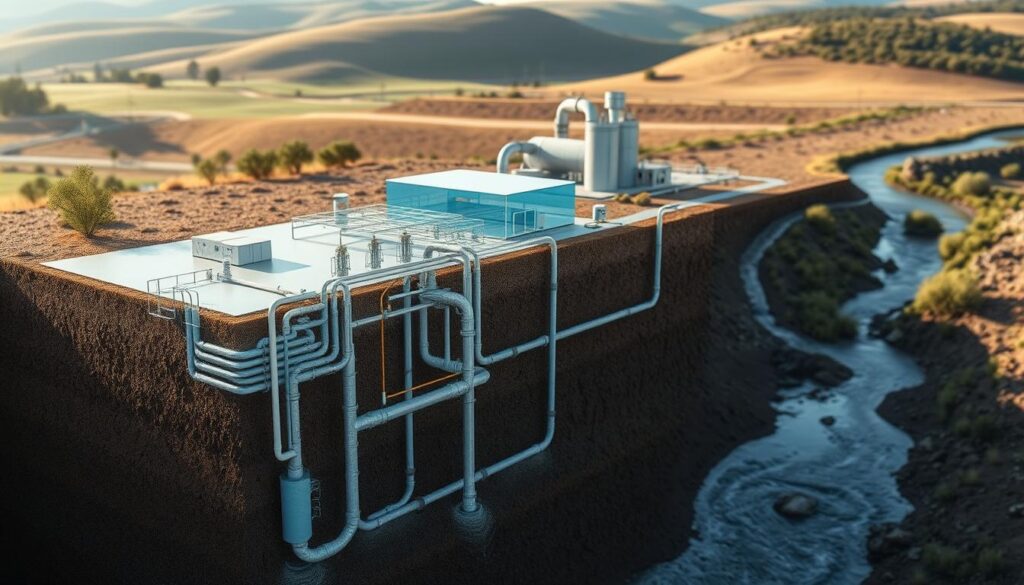As the world grapples with increasing water scarcity and infrastructure challenges, effective water resources management has become more crucial than ever. Can a well-planned civil engineering project be the key to addressing these issues?
Managing a civil engineering project involves a multitude of challenges, from risk management to procurement and contract management. For a comprehensive understanding of these complexities, exploring a civil engineering case study can provide valuable insights.
The importance of water engineering projects in addressing global water challenges cannot be overstated, as highlighted in the DC Water Project Design Manual. This guide aims to provide a detailed overview of water engineering project case studies, focusing on key strategies for managing such projects.
Key Takeaways
- Understanding the complexities of water resources management
- The importance of effective project planning in civil engineering
- Key strategies for managing risk in water engineering projects
- The role of procurement and contract management in project success
- Best practices for project scheduling and budgeting
Introduction to Water Engineering Projects
As the global demand for clean water continues to rise, water engineering projects have become increasingly important. These projects are crucial for managing water resources, providing clean water, and mitigating the effects of floods and droughts.
Importance of Water Engineering
Water engineering is vital for ensuring the sustainability of our water resources. It encompasses a wide range of activities, including the design and implementation of water treatment case studies that help in understanding the effectiveness of different treatment methodologies. According to a study on the role of chemical engineers in water treatment, the application of innovative technologies is crucial for improving water quality environmental engineering project case studies.
The importance of water engineering can be seen in its impact on public health and environmental sustainability. By providing clean water and proper sanitation, water engineering projects help prevent waterborne diseases and protect ecosystems.
Overview of Common Practices
Common practices in water engineering include the design and operation of water supply systems, wastewater treatment facilities, and stormwater management systems. These projects often involve water treatment case studies to evaluate the effectiveness of different treatment processes. For instance, the DC Water Project Design Manual provides guidelines for the design and construction of water infrastructure projects, highlighting best practices in the field.
Effective water engineering projects require a comprehensive understanding of hydrology, hydraulics, and water quality assessment. By applying these principles, engineers can design and implement projects that are sustainable, efficient, and environmentally friendly.
Types of Water Engineering Projects

Managing water resources sustainably involves numerous types of water engineering projects. These projects are crucial for ensuring the availability of clean water, mitigating the effects of flooding, and protecting the environment.
Municipal Water Supply Systems
Municipal water supply systems are designed to provide clean and safe drinking water to communities. These systems involve the collection, treatment, and distribution of water. For instance, the Albuquerque water conservation program has implemented innovative strategies to reduce water consumption, showcasing the importance of efficient municipal water supply systems.
Wastewater Treatment Facilities
Wastewater treatment facilities play a vital role in protecting public health and the environment by treating wastewater before it is discharged into water bodies. Advanced treatment technologies are being adopted to improve the efficiency and effectiveness of these facilities.
Stormwater Management Systems
Stormwater management systems are essential for mitigating the impacts of urban flooding and pollution. These systems involve the design and implementation of infrastructure to manage stormwater runoff, ensuring that it does not harm the environment or communities.
In conclusion, the diversity of water engineering projects highlights the complexity and importance of managing water resources effectively. By understanding the different types of projects, such as municipal water supply systems, wastewater treatment facilities, and stormwater management systems, we can better appreciate the role of water engineering in sustaining our environment and communities.
Key Components of Water Engineering
Understanding the fundamental components of water engineering is crucial for the successful execution of related projects. Water engineering projects are multifaceted and require a comprehensive approach to manage various elements effectively.
Hydrology and Hydraulics
Hydrology and hydraulics are foundational to water engineering. Hydrology involves the study of water resources, including their distribution, circulation, and physical properties. Hydraulics, on the other hand, focuses on the mechanical properties of water and its applications in engineering. Together, they enable the design and operation of water infrastructure, such as dams, canals, and water supply systems.
The DC Water Project Design Manual provides detailed guidelines on hydrologic and hydraulic analyses, emphasizing the importance of accurate data collection and modeling to predict water flow and pressure. This information is critical for designing systems that can efficiently manage water resources and mitigate the risk of flooding or water scarcity.
Water Quality Assessment
Water quality assessment is another critical component of water engineering. It involves evaluating the physical, chemical, and biological characteristics of water to determine its suitability for various uses, such as drinking, irrigation, or industrial applications. Effective water quality assessment requires a thorough understanding of the potential contaminants and their impacts on human health and the environment.
For instance, a sustainable water management case study might involve assessing the water quality in a river basin to identify sources of pollution and implement measures to improve water quality.
| Parameter | Description | Typical Measurement |
|---|---|---|
| pH | Measure of water’s acidity or alkalinity | 6.5-8.5 |
| Turbidity | Measure of water’s clarity | <5 NTU |
| BOD | Measure of organic pollution | <5 mg/L |
Pumping and Treatment Technologies
Pumping and treatment technologies are essential for ensuring that water is delivered safely and efficiently to its intended use. Pumping systems are designed to move water from one location to another, often against gravity, while treatment technologies remove contaminants and pathogens from the water.
Advances in pumping and treatment technologies have significantly improved the efficiency and effectiveness of water engineering projects. For example, the use of variable frequency drives in pumping systems can reduce energy consumption, while advanced oxidation processes in water treatment can remove a wide range of contaminants.
In conclusion, the key components of water engineering, including hydrology and hydraulics, water quality assessment, and pumping and treatment technologies, are crucial for the success of water engineering projects. By understanding and effectively managing these components, engineers can design and implement sustainable water management solutions that meet the needs of communities and protect the environment.
Planning and Designing Water Projects

The planning and design phase is a critical component of water engineering projects, setting the stage for their overall success. This phase involves a comprehensive approach that includes preliminary studies, assessments, and considerations for environmental impact.
Preliminary Studies and Assessments
Preliminary studies are essential for understanding the context and requirements of a water engineering project. These studies typically involve hydrological assessments, water quality analysis, and geotechnical investigations. For instance, a groundwater remediation case study might require detailed assessments of the aquifer’s characteristics and the extent of contamination.
According to the DC Water Project Design Manual, preliminary studies should also consider the project’s feasibility, including technical, financial, and environmental aspects. This ensures that the project is viable and that potential issues are identified early on.
Environmental Impact Considerations
Environmental impact assessments are a critical part of the planning and design process. These assessments evaluate the potential effects of the project on the environment, including impacts on water quality, ecosystems, and local communities. The goal is to minimize adverse effects and ensure that the project is sustainable.
Effective environmental impact assessments involve a thorough analysis of the project’s potential impacts and the development of strategies to mitigate them. This might include measures to protect water resources, reduce waste, and preserve natural habitats.
By integrating preliminary studies and environmental impact assessments into the planning and design phase, water engineering projects can be more effectively managed, ensuring they are both successful and sustainable.
Case Studies of Successful Projects
Examining successful water engineering projects provides valuable insights into best practices and innovative solutions. These case studies not only highlight the challenges faced but also the strategies employed to overcome them, offering lessons for future projects.
The Central Arizona Project
The Central Arizona Project (CAP) is a significant example of a successful water engineering project. It is one of the largest and most complex water delivery systems in the United States, supplying water to municipal, agricultural, and industrial users across Arizona. The CAP demonstrates innovative water management and engineering techniques, including the use of canals, pumping plants, and reservoirs to deliver Colorado River water.
A key aspect of the CAP’s success is its ability to adapt to changing water demands and environmental conditions. The project’s management has implemented various measures to ensure water conservation and efficiency, making it a model for water engineering projects globally.
The New York City Water Supply System
The New York City Water Supply System is another exemplary case study in water engineering. This system is renowned for its complexity and scale, providing clean drinking water to over 9 million people. It is considered one of the most sophisticated water supply systems worldwide, featuring a network of reservoirs, aqueducts, and tunnels.
“The New York City Water Supply System is a testament to the importance of investing in water infrastructure. Its ability to deliver high-quality water to millions of residents is a significant achievement in water engineering.”
The system’s success is attributed to its robust infrastructure and effective management practices, including regular maintenance and water quality monitoring. These efforts ensure the continued provision of safe drinking water, highlighting the importance of long-term planning and investment in water engineering projects.
The Los Angeles Hyperion Treatment Plant
The Los Angeles Hyperion Treatment Plant is a notable example of wastewater treatment innovation. As one of the largest wastewater treatment plants in the United States, it plays a critical role in protecting the environment and public health in the Los Angeles region. The plant’s advanced treatment processes and technologies enable it to handle a significant volume of wastewater, making it a crucial component of the region’s water infrastructure.
The Hyperion Treatment Plant’s success is largely due to its commitment to innovation and environmental stewardship. The plant has implemented various technologies to minimize its environmental footprint, including energy-efficient processes and biosolids management programs. These initiatives demonstrate the potential for water engineering projects to contribute to both environmental protection and community well-being.
Regulatory Framework

Understanding the regulatory landscape is essential for the planning and implementation of water engineering initiatives. The regulatory framework governing these projects is multifaceted, involving various federal, state, and local regulations.
Federal Regulations and Guidelines
Federal regulations play a significant role in shaping water engineering projects. The Clean Water Act and the Safe Drinking Water Act are two pivotal pieces of legislation that set standards for water quality and treatment. Compliance with these regulations is not only mandatory but also crucial for ensuring the environmental sustainability of water projects.
The DC Water Project Design Manual provides detailed guidelines on federal regulatory requirements, emphasizing the importance of adhering to these standards in project design and execution. For instance, the manual outlines the necessary steps for obtaining permits under the Clean Water Act, a critical step in the project approval process.
State and Local Policies
In addition to federal regulations, state and local policies significantly influence water engineering projects. These policies can vary widely, reflecting regional differences in water management needs and environmental concerns. For example, states with significant water scarcity issues may have stricter regulations regarding water conservation and reuse.
Local policies also play a crucial role, as they often address specific community needs and concerns. For instance, local ordinances may dictate the design and implementation of stormwater management systems, reflecting the community’s priorities and environmental conditions.
The interplay between federal, state, and local regulations creates a complex regulatory landscape that project managers must navigate. Understanding these regulations is key to the successful execution of water engineering projects, ensuring not only compliance but also the long-term sustainability of the projects.
Stakeholder Engagement
Stakeholder engagement plays a vital role in water engineering projects, fostering a collaborative environment that leads to more sustainable outcomes. Effective stakeholder engagement ensures that the needs and concerns of the community are addressed, leading to more successful project outcomes.
Community Involvement
Community involvement is a critical aspect of stakeholder engagement in water engineering projects. By engaging with local communities, project developers can gain valuable insights into the needs and concerns of the affected populations. For instance, a case study on Nestle Waters North America’s water conservation highlights the importance of community involvement in achieving sustainable water management.
Strategies for Effective Communication
Effective communication is key to successful stakeholder engagement. This involves not only conveying project information to stakeholders but also listening to their concerns and feedback. Strategies for effective communication include regular updates, public meetings, and the use of clear, accessible language. As discussed in a study on project management leadership, effective communication is crucial for building trust and ensuring project success.
Moreover, the use of technology can enhance stakeholder engagement by providing platforms for feedback and information sharing. This can include online portals, social media, and other digital tools that facilitate communication between project developers and stakeholders.
Funding and Budgeting

The financial backbone of any water engineering project lies in its funding and budgeting. Effective financial planning is crucial for the successful execution of these projects, which often involve significant investment and long-term commitments.
Sources of Funding for Water Projects
Water engineering projects can be funded through various sources, including government grants, private investments, and public-private partnerships. According to a report by Brookings, exploring and improving how state water funding flows amid a surge in federal infrastructure investment is crucial for project viability. You can read more about this in their article on state water funding.
Government grants are often allocated for projects that serve public interests, such as municipal water supply systems and wastewater treatment facilities. Private investments, on the other hand, are typically directed towards projects with potential for financial returns, such as hydropower projects.
Cost-Benefit Analysis
A thorough cost-benefit analysis is essential for evaluating the viability of water engineering projects. This involves assessing both the direct and indirect costs associated with the project, as well as the anticipated benefits.
| Project Component | Cost | Benefit |
|---|---|---|
| Municipal Water Supply | $10 million | Improved water quality for 1 million residents |
| Wastewater Treatment | $5 million | Reduced environmental pollution |
| Hydropower Generation | $20 million | Renewable energy for 500,000 households |
By conducting a detailed cost-benefit analysis, stakeholders can make informed decisions about project feasibility and prioritize investments that offer the greatest benefits.
Implementation Challenges
Water engineering projects face numerous implementation challenges, from technical hurdles to environmental concerns. These challenges can significantly impact project timelines, budgets, and overall success.
Technical and Engineering Hurdles
Technical challenges are a significant aspect of water engineering projects. For instance, the construction of wastewater treatment facilities often involves complex engineering tasks, such as designing efficient treatment processes and ensuring the structural integrity of the facilities. According to the DC Water Project Design Manual, technical challenges can arise from unforeseen site conditions, technological limitations, and regulatory compliance issues.
To mitigate these challenges, project managers must engage in thorough planning and design. This includes conducting detailed site assessments, selecting appropriate technologies, and ensuring that all designs meet or exceed regulatory standards. For example, a study on water and wastewater construction projects highlights the importance of addressing technical challenges proactively to avoid costly delays and modifications.
Climate Change Impacts
Climate change poses another significant challenge to water engineering projects. Rising temperatures and changing precipitation patterns can alter water availability, affect water quality, and increase the frequency of extreme weather events. These changes can have profound implications for water supply systems, wastewater treatment facilities, and stormwater management infrastructure.
For example, increased rainfall intensity due to climate change can overwhelm stormwater systems, leading to urban flooding and pollution. Conversely, droughts can strain water supply systems, necessitating innovative management strategies. An environmental engineering project case study on adapting water infrastructure to climate change can provide valuable insights into effective adaptation measures.
| Challenge | Impact | Mitigation Strategy |
|---|---|---|
| Technical Hurdles | Delays, Cost Overruns | Thorough Planning, Advanced Technology |
| Climate Change | Water Scarcity, Infrastructure Damage | Climate-Resilient Design, Adaptive Management |
| Regulatory Compliance | Legal Issues, Project Halts | Regular Audits, Compliance Training |
In conclusion, addressing the implementation challenges in water engineering projects requires a multifaceted approach that includes technical innovation, climate resilience, and regulatory compliance. By understanding these challenges and implementing effective mitigation strategies, project managers can ensure the successful delivery of water engineering projects.
Technology in Water Engineering

The integration of technology in water engineering has revolutionized the way we manage water resources. This section explores the significant advancements in this field, particularly in water treatment and smart water management systems.
Innovations in Water Treatment
Recent years have seen substantial innovations in water treatment technologies. One notable example is the use of AI-based systems in water injection plants, as highlighted in a case study on AI-based control systems. Such technologies enhance the efficiency and effectiveness of water treatment processes.
Advanced water treatment technologies include membrane filtration, UV disinfection, and advanced oxidation processes. These technologies improve water quality by removing contaminants and pathogens, making water safe for consumption and other uses.
Smart Water Management Systems
Smart water management systems leverage technologies like IoT sensors, data analytics, and cloud computing to optimize water distribution and consumption. These systems enable real-time monitoring and management of water resources, reducing waste and improving sustainability.
A key benefit of smart water management is its ability to detect leaks and predict maintenance needs, thereby reducing operational costs and environmental impact. For instance, a sustainable water management case study might involve the implementation of smart metering systems to monitor water usage patterns and identify areas for improvement.
| Technology | Application | Benefits |
|---|---|---|
| AI-based control systems | Water injection plants | Enhanced efficiency, improved water quality |
| IoT sensors | Real-time water monitoring | Reduced waste, improved sustainability |
| Advanced oxidation processes | Water treatment | Removal of contaminants and pathogens |
By embracing these technological advancements, water engineering projects can achieve greater efficiency, sustainability, and reliability, ultimately contributing to better water resources management.
Monitoring and Evaluation
Monitoring and evaluation play a pivotal role in determining the efficacy of water engineering initiatives. By systematically assessing project performance, stakeholders can identify areas for improvement and ensure that projects meet their intended objectives.
Performance Metrics
Performance metrics are essential for evaluating the success of water engineering projects. These metrics may include water quality parameters, such as pH and turbidity levels, as well as operational efficiency metrics, like energy consumption and treatment capacity utilization. By tracking these metrics, project managers can make informed decisions to optimize project performance.
For instance, a water treatment plant might monitor its effluent quality to ensure compliance with regulatory standards. This involves regular sampling and analysis to measure parameters such as biochemical oxygen demand (BOD) and total suspended solids (TSS).
Long-term Sustainability of Projects
Ensuring the long-term sustainability of water engineering projects requires careful planning and ongoing evaluation. This involves assessing the project’s environmental impact, social acceptability, and economic viability over its lifecycle. Strategies for enhancing sustainability include implementing energy-efficient technologies and adopting water conservation practices.
A case study on the DC Water Project Design Manual highlights the importance of incorporating sustainable practices into water infrastructure projects. By doing so, water utilities can reduce their environmental footprint while maintaining reliable service delivery.
In conclusion, effective monitoring and evaluation are critical components of successful water engineering projects. By leveraging performance metrics and focusing on long-term sustainability, stakeholders can ensure that these projects deliver lasting benefits to communities and the environment.
Future Trends in Water Engineering

The future of water engineering is being shaped by innovative technologies and sustainable practices. As we move forward, the industry is expected to witness significant advancements in various areas.
Emerging Technologies
One of the key drivers of change in water engineering is the adoption of emerging technologies. These include advanced water treatment technologies such as membrane bioreactors and advanced oxidation processes, which are enhancing the efficiency and effectiveness of water treatment processes.
For instance, innovative approaches to water supply management are being explored to address the challenges posed by climate change and population growth.
Water Resource Management Practices
In addition to technological advancements, there is a growing emphasis on sustainable water resource management practices. This includes the adoption of integrated water resources management approaches that consider the social, economic, and environmental dimensions of water use.
Effective water resource management is critical for ensuring the long-term sustainability of water engineering projects. It involves not only the efficient use of water but also the protection of water sources and ecosystems.
By embracing these future trends, the water engineering sector can address the complex challenges it faces and contribute to a more water-secure future.
Best Practices in Project Management
The success of water engineering projects hinges on the application of robust project management principles. Effective project management ensures that projects are completed on time, within budget, and to the required quality standards.
Water engineering projects, such as those involving water treatment or hydropower, are complex and involve multiple stakeholders. Therefore, adopting best practices in project management is crucial for their success.
Project Lifecycle and Milestones
Managing a water engineering project through its lifecycle involves several key stages, from initiation and planning to execution and closure. Each stage has specific milestones that must be achieved to ensure the project’s overall success.
- Initiation: Defining project scope and objectives
- Planning: Developing detailed project plans and schedules
- Execution: Carrying out the project work according to the plan
- Monitoring and Control: Tracking project progress and making adjustments as necessary
- Closure: Completing the project and evaluating its success
For instance, a water treatment case study might involve significant planning and execution phases, with milestones such as completing the design phase, obtaining necessary permits, and commencing operations.
Risk Management Strategies
Risk management is a critical aspect of project management in water engineering. It involves identifying potential risks, assessing their impact, and developing strategies to mitigate them.
| Risk Category | Examples | Mitigation Strategies |
|---|---|---|
| Technical Risks | Design flaws, equipment failure | Thorough design review, equipment testing |
| Financial Risks | Cost overruns, funding delays | Detailed budgeting, securing multiple funding sources |
| Environmental Risks | Natural disasters, environmental impacts | Environmental impact assessments, contingency planning |
Effective risk management can significantly reduce the likelihood of project delays or cost overruns, as seen in successful hydropower project case studies.
In conclusion, applying best practices in project management is essential for the success of water engineering projects. By understanding the project lifecycle, setting clear milestones, and implementing robust risk management strategies, project managers can ensure that their projects are completed successfully.
Case Study Analysis Techniques

To gain a deeper understanding of water engineering projects, it’s necessary to apply rigorous case study analysis techniques. These techniques enable researchers and practitioners to evaluate the effectiveness of various water management strategies and identify areas for improvement.
Qualitative vs. Quantitative Analysis
Case study analysis in water engineering often involves a combination of qualitative and quantitative methods. Qualitative analysis focuses on the non-numerical aspects of a project, such as stakeholder engagement, community impact, and environmental effects. This type of analysis provides valuable insights into the social and environmental implications of water engineering projects.
Quantitative analysis, on the other hand, relies on numerical data to assess project performance. This may include metrics such as water quality parameters, flow rates, and cost-benefit analyses. By combining qualitative and quantitative approaches, researchers can develop a comprehensive understanding of a project’s strengths and weaknesses.
Lessons Learned from Past Projects
Analyzing past water engineering projects can provide valuable lessons for future initiatives. For example, a groundwater remediation case study might reveal the importance of thorough site characterization and the need for ongoing monitoring to ensure the long-term effectiveness of remediation efforts.
A sustainable water management case study could highlight the benefits of integrating water conservation measures with wastewater management strategies. By examining the successes and challenges of past projects, researchers and practitioners can identify best practices and develop more effective strategies for future water engineering initiatives.
| Case Study | Key Findings | Lessons Learned |
|---|---|---|
| Groundwater Remediation Project | Importance of site characterization, need for ongoing monitoring | Thorough planning and long-term commitment are crucial for success |
| Sustainable Water Management Initiative | Integration of water conservation and wastewater management | Holistic approaches can lead to more effective and sustainable outcomes |
Conclusion and Recommendations
Effective water engineering project case studies provide valuable insights into the planning, design, and implementation of infrastructure project case studies. By analyzing successful projects, such as the Central Arizona Project and the New York City Water Supply System, we can identify best practices and common challenges.
Key Takeaways for Future Projects
Future water engineering projects can benefit from a thorough understanding of hydrology and hydraulics, as well as the importance of stakeholder engagement and community involvement. By leveraging innovations in water treatment and smart water management systems, projects can improve efficiency and sustainability.
To ensure long-term success, it is crucial to conduct thorough preliminary studies and assessments, consider environmental impact, and develop effective risk management strategies. By applying these key takeaways, future water engineering projects can better address the complex challenges associated with infrastructure project case studies.
